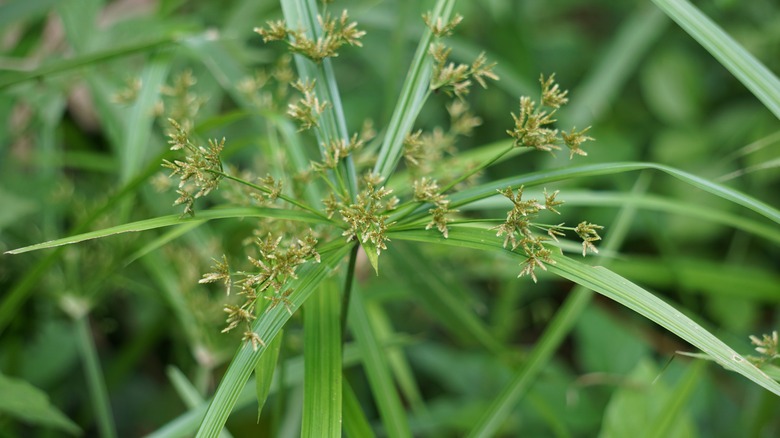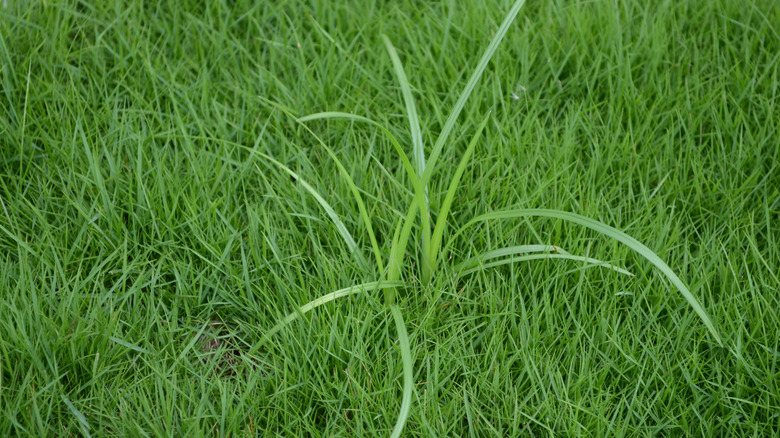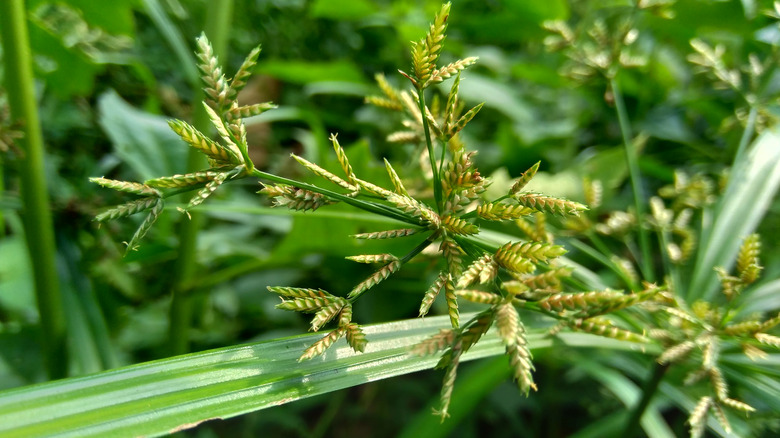If Invasive Nutsedge Is Taking Over Your Lawn, This Is What Pinterest Recommends
Is nutsedge taking over your lawn? Pinterest recommends using a sedge-specific herbicide as one of the best ways to effectively control nutsedge in your lawn or garden. However, this method does include using a pesticide, so there are some things to keep in mind when deciding whether this is the route you want to take for nutsedge removal. Nutsedge is one of the most challenging weeds to get rid of in the lawn or garden. Once established, it is nearly impossible to remove, primarily due to its growth and reproductive habits. Before going the chemical route, there are other methods available to kill nutsedge, depending on the severity of your infestation.
However, the chemical herbicide that Pinterest recommends is called Sedgehammer+. The main active ingredient is Halosulfuron-methyl 5%, which comes in a liquid or powdered form. It's a systematic herbicide that moves through the plant's cells, so it may take a few weeks to kill it off entirely. It is also one of the most "gentle-to-turf" pesticides for nutsedge control, so your turf grass should be fine; however, do use caution. Be careful not to get it on any desirable plants, as there is always a risk of damage when using toxic chemicals. Sledgehammer+ is a post-emergence herbicide, meaning it should be used on fully grown nutsedge. Pre-emergents are typically not effective for nutsedge removal due to the plant's resilient underground tubers, and they're usually unsafe for turf grasses.
What is nutsedge?
There are two main kinds of invasive nutsedge species that may be present in your yard: Yellow nutsedge (Cyperus esculentis) and purple nutsedge (Cyperus rotundus). Both species have a highly aggressive reproductive growth habit, making them pesky weeds in any lawn or garden. Since they are typically lighter in color, they stick out like a sore thumb in the lawn and create a non-uniform turf appearance. Nutsedges are incredibly difficult to remove, primarily because of their reproductive habit. They grow from seed, rhizomatic roots, and tubers, which means they can quickly colonize an area underground and aboveground.
Naturally occurring in Europe, the Middle East, and Africa, it is unclear how or when it was introduced to the United States. In its native range, it is an important food crop. In Spain, the nutty tubers are used to make a beverage called horchata. In parts of Northern Africa, it is known as Chufa, and grown for its edible tubers that are naturally high in protein, carbohydrates, natural sugars, fiber, and oils. Pig farmers in the Southern U.S. states of Georgia and Florida cultivate it for their pigs as it provides a nutrient-rich feed. While it is currently notorious as an invasive and noxious weed, Native Americans would harvest the nutritious tubers for various edible uses. However, it's a weedy pest in the wrong environments. Furthermore, nutsedge weed prevention can take many different approaches.
How to use Sedgehammer+ and other alternatives
Sedgehammer+ is the top recommended way to chemically remove nutsedge from your yard. The powder is an inexpensive and easy option. Mix one packet into a gallon of water in a tank or herbicide sprayer and spray the affected area. This amount should cover 1,000 square feet. It should take 10-14 days to see results, so getting a few packets to reapply may be necessary. However, it is imperative to note that Sledgehammer+ is not safe for use near edible plants or garden beds. Additionally, it is a pesticide, so be sure to use it responsibly. Check out this warning on the use of pesticides from the University of California Agriculture and Natural Resources division for safety and disposal.
If chemicals aren't your thing, other cultural practices can help get rid of nutsedge in your yard or garden without pesticides. However, this is highly dependent on how infested your yard is. If your yard is completely covered in nutsedge, getting rid of it is next to impossible. You can remove it by hand, but you want to make sure that you are digging out 10 inches in diameter around the plant. Since they regrow from rhizomes and tubers, you want to get as much of the root ball as possible. Since nutsedge loves moisture, you can also dry them out by calibrating your irrigation accordingly. This will deprive nutsedge of what it needs to survive and cause it to die naturally.


